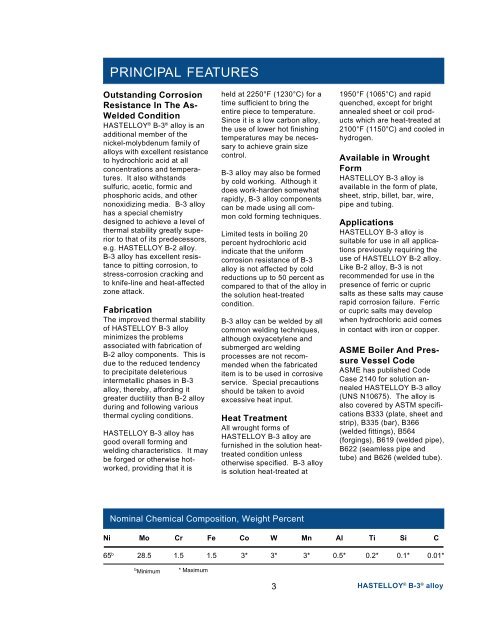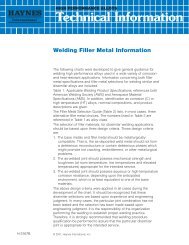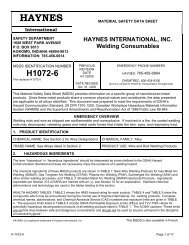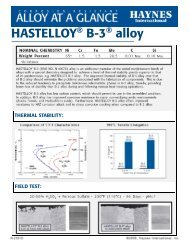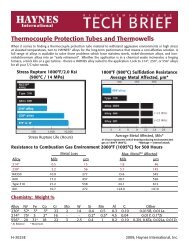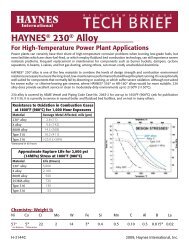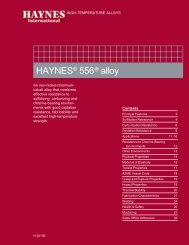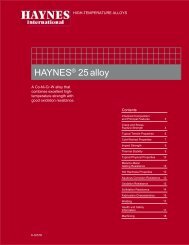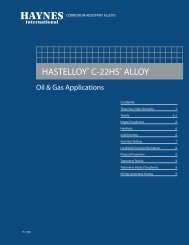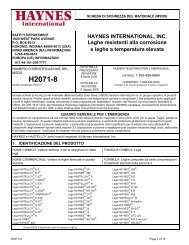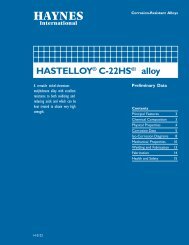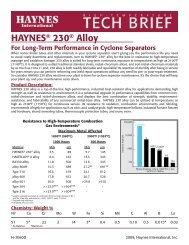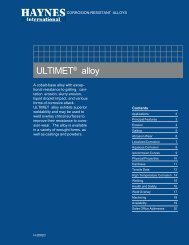HASTELLOY® B-3® alloy - Haynes International, Inc.
HASTELLOY® B-3® alloy - Haynes International, Inc.
HASTELLOY® B-3® alloy - Haynes International, Inc.
Create successful ePaper yourself
Turn your PDF publications into a flip-book with our unique Google optimized e-Paper software.
PRINCIPAL FEATURES<br />
Outstanding Corrosion<br />
Resistance In The As-<br />
Welded Condition<br />
HASTELLOY ® B-3 ® <strong>alloy</strong> is an<br />
additional member of the<br />
nickel-molybdenum family of<br />
<strong>alloy</strong>s with excellent resistance<br />
to hydrochloric acid at all<br />
concentrations and temperatures.<br />
It also withstands<br />
sulfuric, acetic, formic and<br />
phosphoric acids, and other<br />
nonoxidizing media. B-3 <strong>alloy</strong><br />
has a special chemistry<br />
designed to achieve a level of<br />
thermal stability greatly superior<br />
to that of its predecessors,<br />
e.g. HASTELLOY B-2 <strong>alloy</strong>.<br />
B-3 <strong>alloy</strong> has excellent resistance<br />
to pitting corrosion, to<br />
stress-corrosion cracking and<br />
to knife-line and heat-affected<br />
zone attack.<br />
Fabrication<br />
The improved thermal stability<br />
of HASTELLOY B-3 <strong>alloy</strong><br />
minimizes the problems<br />
associated with fabrication of<br />
B-2 <strong>alloy</strong> components. This is<br />
due to the reduced tendency<br />
to precipitate deleterious<br />
intermetallic phases in B-3<br />
<strong>alloy</strong>, thereby, affording it<br />
greater ductility than B-2 <strong>alloy</strong><br />
during and following various<br />
thermal cycling conditions.<br />
HASTELLOY B-3 <strong>alloy</strong> has<br />
good overall forming and<br />
welding characteristics. It may<br />
be forged or otherwise hotworked,<br />
providing that it is<br />
held at 2250°F (1230°C) for a<br />
time sufficient to bring the<br />
entire piece to temperature.<br />
Since it is a low carbon <strong>alloy</strong>,<br />
the use of lower hot finishing<br />
temperatures may be necessary<br />
to achieve grain size<br />
control.<br />
B-3 <strong>alloy</strong> may also be formed<br />
by cold working. Although it<br />
does work-harden somewhat<br />
rapidly, B-3 <strong>alloy</strong> components<br />
can be made using all common<br />
cold forming techniques.<br />
Limited tests in boiling 20<br />
percent hydrochloric acid<br />
indicate that the uniform<br />
corrosion resistance of B-3<br />
<strong>alloy</strong> is not affected by cold<br />
reductions up to 50 percent as<br />
compared to that of the <strong>alloy</strong> in<br />
the solution heat-treated<br />
condition.<br />
B-3 <strong>alloy</strong> can be welded by all<br />
common welding techniques,<br />
although oxyacetylene and<br />
submerged arc welding<br />
processes are not recommended<br />
when the fabricated<br />
item is to be used in corrosive<br />
service. Special precautions<br />
should be taken to avoid<br />
excessive heat input.<br />
Heat Treatment<br />
All wrought forms of<br />
HASTELLOY B-3 <strong>alloy</strong> are<br />
furnished in the solution heattreated<br />
condition unless<br />
otherwise specified. B-3 <strong>alloy</strong><br />
is solution heat-treated at<br />
1950°F (1065°C) and rapid<br />
quenched, except for bright<br />
annealed sheet or coil products<br />
which are heat-treated at<br />
2100°F (1150°C) and cooled in<br />
hydrogen.<br />
Available in Wrought<br />
Form<br />
HASTELLOY B-3 <strong>alloy</strong> is<br />
available in the form of plate,<br />
sheet, strip, billet, bar, wire,<br />
pipe and tubing.<br />
Applications<br />
HASTELLOY B-3 <strong>alloy</strong> is<br />
suitable for use in all applications<br />
previously requiring the<br />
use of HASTELLOY B-2 <strong>alloy</strong>.<br />
Like B-2 <strong>alloy</strong>, B-3 is not<br />
recommended for use in the<br />
presence of ferric or cupric<br />
salts as these salts may cause<br />
rapid corrosion failure. Ferric<br />
or cupric salts may develop<br />
when hydrochloric acid comes<br />
in contact with iron or copper.<br />
ASME Boiler And Pressure<br />
Vessel Code<br />
ASME has published Code<br />
Case 2140 for solution annealed<br />
HASTELLOY B-3 <strong>alloy</strong><br />
(UNS N10675). The <strong>alloy</strong> is<br />
also covered by ASTM specifications<br />
B333 (plate, sheet and<br />
strip), B335 (bar), B366<br />
(welded fittings), B564<br />
(forgings), B619 (welded pipe),<br />
B622 (seamless pipe and<br />
tube) and B626 (welded tube).<br />
Nominal Chemical Composition, Weight Percent<br />
Ni Mo Cr Fe Co W Mn Al Ti Si C<br />
65 b 28.5 1.5 1.5 3* 3* 3* 0.5* 0.2* 0.1* 0.01*<br />
b Minimum<br />
* Maximum<br />
3 HASTELLOY ® B-3 ® <strong>alloy</strong>


